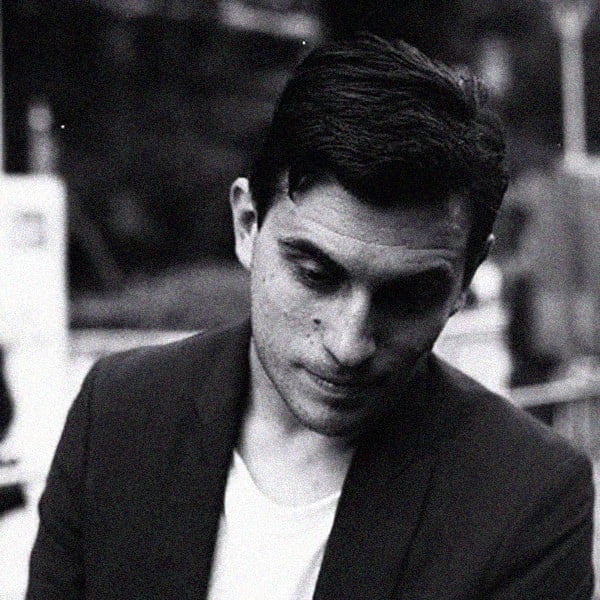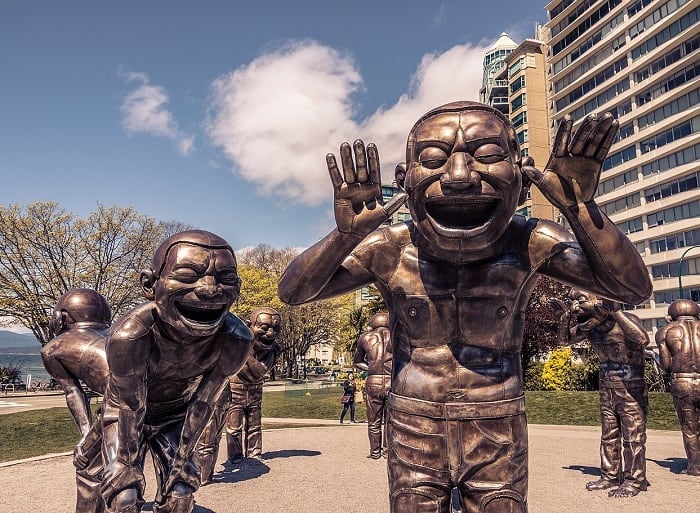Articles and Features
Cooler Heads.
Yue Minjun and the Lessons of the Recent Past

William Pym, Standards & Practices, Volume 16
Comedian Dave Chappelle has a bit in a recent standup special where he talks about being called to the Standards and Practices department of his cable network and being told to do things differently. He’s not too bothered about what the network thinks. There’s a vulgar, uproarious punchline. I like the idea of standards and practices. It makes for a good joke. The enforcer of arbitrary rules and norms, a person whose job it is to frame what’s right, right now. For how can you tame a moment? In the international art world, where I have worked since 2002, I grew to become very familiar with a world of amorality, grandiosity and arrogance. I watched pre-2008 hypercapitalism change everyone’s style, and watched money get darker. Now the art world is being rebuilt, like everything else, in the image of a new generation. And one thing is true now as it was then — the art world is a place of porous standards, and practice takes many forms. I am still here, somehow, and I am the Standards and Practices department.
Artworks, like world events, lose definition and meaning with a bit of distance. As the present consumes us, yesterday gets dusty fast. Vietnam, say, is now a faded memory, a pop-cultural event more than anything else. War’s toll means little when it loses the crunch of current events. So too Modernism, an art movement fundamentally about keeping tempo with modern life, reads now like pre-history after everything the end of the 20th century brought about. The tempo of life has accelerated; looking back becomes harder work with so much immediately around us, requiring our attention. I am, for this reason, an advocate of relitigating the recent past to gain perspective on the present. In today’s art world we are living in a long season of wacky whiplash auction results, a soap opera of microtrends evolving by the week, and a sideshow feel best embodied by the rushed embrace of NFT quote-unquote art in the past year. Perspective sometimes feels impossible. It occurred to me that a look back at the emergence of the contemporary art scene in China in the 1990s might mean something different than it did the first time around, in its own moment of money, mania and rapid change.
Yue Minjun grew up in far Northeast China, moving around. His father worked in oil fields. He painted through his 20s while doing manual labour himself, and found fluency and a groove as an expressive draftsman. An early large-scale group portrait The Artist and his Friends (1991) portrays a clique of characters with clear affection and charming specificity, all in a slightly smushed, fleshy fashion similar in soulfulness to Stanley Spencer or Lucian Freud in the 1950s. He could really paint, but this was not to be his style. Inspired by a single painting of a face frozen in laughter — Geng Jianyi’s Second Situation (1987) — Yue came upon his own laughing man, a cartoonish self-portrait with his eyes pinched and head tipped back revealing dazzling white teeth and a chasm of black in his mouth. The laughing man became his subject and remains so, 30 years later. He is an indelible figure. He is a very successful figure.

Yue’s mature paintings are in certain aspects highly uniform, in others wildly varied. The quality of light, bright and flat, is a constant. The brushwork stays the same. They are qualitatively plain. The laughing man always comes across the same, same palette and proportions, same hot pink skin. The laugh is always the same volume. In subject, conversely, Yue is open to everything. The men might be falling in space, bundled together in a sea of heads, mugging as if for a photograph, or crawling like worms out of the pits of scholar’s rocks. they might operate at the outer limits of goofiness, aping Marilyn Monroe in The Seven-Year Itch, or hit an unexpected nerve, as in the 1995 riff on Delacroix’s Liberty Leading the People with its echoes of modern revolutionary protest.
The laughing man, his image, traveled the world in the 1990s. As the paintings grew more desirable he became an emblem of the new global art landscape, where the market and the terms of discourse needed not originate in the western power centres. The laughing man’s face, an immovable and unresolvable thing, paradoxically symbolized change, a new world. And he did it without words. Speculation about the meaning of the laughing man evolved dramatically alongside his racing market. He represented resignation or surrender to absurdity, perhaps, in the rubble of Tiananmen Square and the renewed restrictions on public expression. His boldest political work, 1995’s Execution, puts laughing men in borrowed setups from both Goya and Manet’s paintings of the execution of Emperor Maximilian, with the tiled red wall of Tiananmen across the back of the composition. Or perhaps the man represented a gnomic everyman, humanity distilled into a howl upon which we may project an exhortation of our own, an extended meditation and chuckle about the human condition. Both interpretations fit, despite being in opposition to each other. As the work joined the discussion of capitalism and the sport of art trading, woollier interpretations took shape while the men laughed in the illustrations of opinion pieces in the Financial Times or The Economist. Perhaps the work is darker and deeply sardonic, challenging China by reaching past its boundaries and breaking its yoke in an act of deeply coded, clever resistance to censorship. Or perhaps the laughing man is craven, knowing what’s possible and milking the west for profit by exploiting the simplicity of western consumer culture now that it is available to him.
The debate about meaning raged for years, without resolution. Many refused to take the work seriously, viewing it as kitsch. Others insisted on political meaning at its core, that it must refer to China first. Yue demurred when he could have pinned matters down, urging viewers of Execution to consider political murder as a whole, even though Tiananmen Square was the painting’s inspiration. He didn’t embrace the catchy designation of Cynical Realism coined by critic Li Xianting in 1992, feeling it was too restrictive. We as western viewers at that time were left with ambiguity about what the work meant, which was a curious bag to be in during an era where the instinct of players in the scene — be they collectors, critics or other artists — was to consider art as something to be mastered, packaged and marketed. Yue’s paintings hurtled through a hectic, high-stakes present, refusing answers.
Those paintings are history; we have new hysterical unresolvable questions now, and even more money flying around. So what does the laughing man look like from here, from now, and what lessons should we take from him? After all these years, it feels like a single word will do. Opportunity. The laughing man presented the artist with an opportunity to be both political or apolitical without having to answer for it. He presented the artist with an opportunity to be honest about the complexity of his feelings, or be very silly. Yue found the laughing man, and the laughing man revealed to him that there was a way to exist that had not been available to him before — a way of transcending politics, honoring the individual, embracing the absurd, and being successful. Divorced from the clattering noise of its moment, Yue’s paintings may now represent something as simple as freedom. Everything that came to him was a result of that freedom. The fact that this interpretation was sitting there all along but only seems clear now is a reminder that the most basic principles are the most easily overlooked, but often prove to be the most durable. Keep that in mind for the future.
Relevant sources to learn more
William Pym, Standards & Practices, Vol.10 : Working Through A Daze With Dana Schutz
William Pym, Standards & Practices, Vol.11 : Halfway To The Future. Saatchi Yates’ Proposal For Tomorrow’s Art Gallery
William Pym, Standards & Practices, Vol.12 : The Body Won’t Quit. Finding a Way Through 2021
William Pym, Standards & Practices, Vol.13 :Thomas Hirschhorn and Our Life in Ruins
William Pym, Standards & Practices, Vol.14 : A Mellowing Dictator. How I Learned to Stop Worrying and Love Jonathan Meese
William Pym, Standards & Practices, Vol.15 : Yours For the Taking: Justine Kurland’s Continuing Story of Freedom in America

